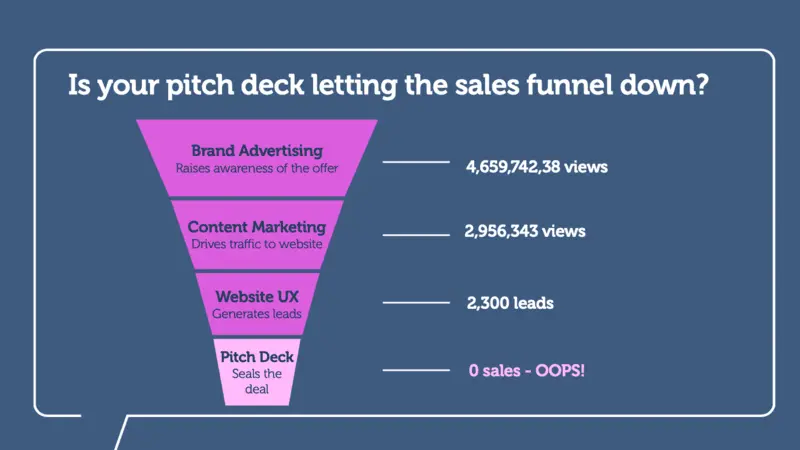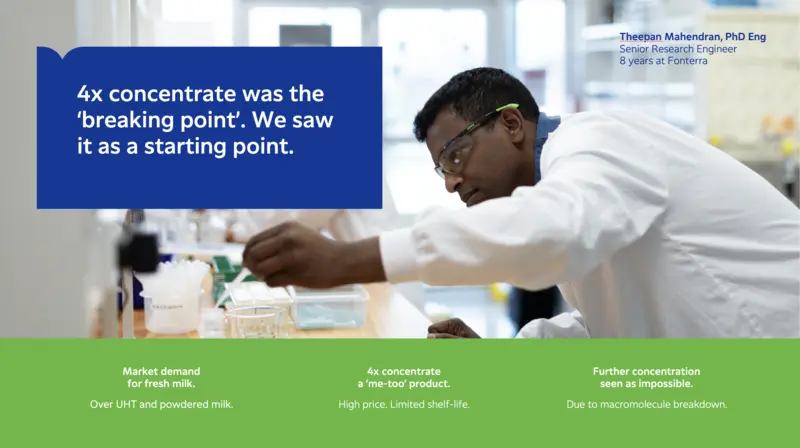

On average, marketers write 55 presentations a year. The issue is that we're all so busy, we usually show up and throw up! Here are eight content and copywriting tips to turn an average pitch into a persuasive proposal.
Over the holidays, I read Birdsong by Sebastian Faulks. It's a WWI story about miners on the frontline. While the enemy lay sleeping no more than 200 metres away, the miner’s job was to dig a tunnel under no man’s land and lay a mine under their feet.
As an analogy, this is what's happening to communications right now.
Big budgets and television ad spending have gone quiet. But there is still a lot of activity happening underground. The real heroes are your sales reps, who chip away at prospective customers day in and day out, armed only with a PowerPoint presentation.

Let’s face it: we hate doing presentations - and your audience is bored too. One-fifth of people look at another screen constantly during presentations. I was recently talking to a top Trade and Enterprise official who said, off the record, that most exporters pitching for business overseas had very poor presentations.
So, the first thing to do is…

This will cost you nothing except an hour of your time. Gather all your company’s presentations. Lay them out on a physical table with your team, including the Sales Director. Take post-it notes, then make good, bad, and ugly points on each slide.

Money down, you'll discover that each staff user has ‘adapted’ your company pitch. It will consist of some on-brand paragraphs, poorly worded bullet points, three different fonts, and a visual downloaded from the net amidst your brand imagery. Nice.
Don’t expect the luxury of a laptop presentation, either. Your presentation will most likely be viewed from a mobile phone over a beer with a customer, or a few key pages will be screenshotted. (I once sat beside All-Black coach Scott Robertson, who showed me the Crusader strategy in two slides).

Having won our fair share of political campaigns, we can tell you that it’s all won or lost in the narrative we create at the very start.
Your job is to give your recipient, like voters, a clear choice between you and your competitors... except that choice is only you, and it’s perfectly clear!
Now, make that into an elevator pitch (usually a sentence). Now make that into a 50-word pitch. Now, a 200-word pitch with proof points. Now, you have a pitch story (not a brand story) and a narrative for your master presentation.
Even if you are just doing an internal presentation to your boss, think about the ONE point you want them to have lodged in theit mind, then rally the story behind it.


Every good marketer and creative will tell you that authentic insights—the truth told well—are your secret weapon.
We recently did a project for Fonterra to showcase their deep R&D innovation capabilities. Here’s what we discovered talking to the bright sparks in the lab.
Get out from behind the desk. Be curious. Talk to your customers, product team, R&D, and sales team. Take the time to understand the fantastic technology and expert insights that add weight to your argument.

Years ago, as a junior copywriter, I cut my teeth creating pharmaceutical presentations for sales reps visiting doctors.
The client and I would start with a stack of A4 papers and a marker pen. Then, we would work out the logical flow of the presentation, creating a slide a page (sorry Earth) and moving them around until we had a compelling argument.
Today, you can do the same thing on a Teams call using Miro. We have created entire UX flows on Miro, adding information and notes with up to 30 stakeholders adding their expertise.

Either way, nail down and agree to the logic flow of the entire presentation before you start writing the pages. And when you do start writing, here’s a great trick – do all the headlines first. Does the narrative flow over 30 slides?

Guy Kawasaki's 10-20-30 Rule for PowerPoint presentations emphasises three key principles:
1. Ten slides: Limit the number of slides to a maximum of 10.
2. Twenty minutes: Keep the presentation duration to no more than 20 minutes.
3. Thirty-point font: Use a minimum font size of 30 points for all text on the slides
My tip is to imagine driving down Parnell Hill and seeing each slide on the billboard at the bottom.

The art of not boring your audience in a presentation to death is never easy. The best storyteller I have ever heard was Peter Moore. (They say, as a GM, he was so good at rejecting a concept that creatives would end up thanking him!)
Stories are 22 times more memorable than facts alone, according to research by Stanford marketing professor, Jennifer Aakar. Information retention increases from 5-10% to 67% when data is combined with a story.
By stories, I don’t mean you have to tell anecdotes or funny stories —although that’s good, too! Stories can also explain your product in layman’s terms, break down data using graphics so that it is more easily understood, or make the headline more intriguing.

While writing a presentation on ultrafiltration for Fonterra R&D, I discovered one of the most significant issues in the late 1900s was residue whey clogging the pipes. The Director’s wife came up with the answer - Bio Luvil washing powder!

New companies sell the vision, but credible companies let their case stories do the heavy lifting. I cannot emphasise enough how dedicated you must be to documenting your stories for websites, social media, and presentations.
It can be a pretty onerous task, so here’s a simple process we use to make it easier:
Don’t forget to grab photos and any behind-the-scene shots of the moment while doing the job. Otherwise, this is lost.

As a writer, I will always say good, clear communication is key. All too often marketers chuck something at designer but haven't actually thought about WHAT they are saying.
Having said that, I'm appalled at how rough some presentations look. This is your company image!
There are plenty of presentation templates out there, but if you are in a corporation PowerPoint is secure, has AI capabilities and is practical; all your team know how to use it. My advice is:
In 2025, the economy will only grow by 0.5%. Make no mistake—it’s a battle out there.
But, like the miners 200m under the earth, stealth is the key to wealth. The key to winning your next business pitch, might just be a killer Powerpoint.
